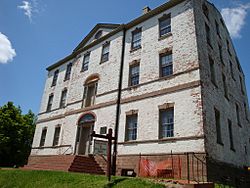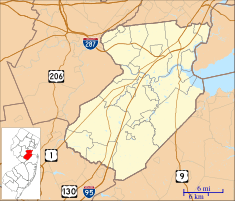Proprietary House facts for kids
|
The Proprietary House
|
|

Proprietary House in 2009
|
|
| Location | 149 Kearny Ave Perth Amboy, NJ 08861 |
|---|---|
| Nearest city | Edison, New Jersey, U.S. |
| Area | 0.6 acres (0.0024 km2) |
| Built | 1762 |
| Built by | John Edward Pryor |
| Architect | John Edward Pryor |
| Architectural style | Georgian |
| Restored | began in 1985 |
| Restored by | The Proprietary House Association |
| NRHP reference No. | 71000509 |
Quick facts for kids Significant dates |
|
| Designated | February 24, 1971 |
The Proprietary House in Perth Amboy, New Jersey is a really old and important building. It's the only house still standing that was built for a proprietary governor in the original Thirteen Colonies of America!
An architect and builder named John Edward Pryor started building this grand Georgian-style mansion in 1762. It was finished in 1764. The first person to live there was Chief Justice Frederick Smyth, who rented it from 1766 to 1773. In 1773, the house was fixed up to become the home of New Jersey's royal governor.
Contents
A Look Back: The House's Early Years
The 18th Century: Governors and Revolution
From 1774 to 1776, the Royal Governor of New Jersey, William Franklin, lived in the Proprietary House. He was the son of the famous Benjamin Franklin.
The American Revolution's Impact
In January 1776, as the American Revolutionary War began, Governor Franklin was put under house arrest by the Provincial Congress of New Jersey. In June 1776, he was arrested and sent to prison in Litchfield, Connecticut. He was later released in a prisoner exchange in 1778.
During or after the Revolutionary War, the Proprietary House was badly damaged. A fire destroyed the inside. In 1792, an advertisement mentioned that the "remains of the house lately burned" were for sale.
In 1794, John Rattoon bought the property. He later became the mayor of Perth Amboy. Rattoon fixed up the house, tearing down the damaged back part of the upper story and adding a new roof.
The 19th Century: Hotels and Homes
The Brighton Hotel Era
In 1808, Rattoon sold the house to Richard M. Woodhull, who turned it into a hotel called The Brighton. Woodhull added a three-story wing and two more stories to the main part of the house. He also changed the front door and added a two-story porch. Many of the beautiful wooden details you see inside today are from this time.
In 1809, a newspaper called The New-York Gazette described The Brighton Hotel as a "charming place." However, the War of 1812 soon stopped tourism, and the hotel closed.
The Bruen Family Home
In 1817, the house was sold to Matthias Bruen, a wealthy merchant from Perth Amboy. He lived there until he passed away in 1846. His family later made important contributions to American history.
After Bruen's death, his family renovated the property and reopened it as The Brighton hotel, but with simpler rooms. However, wars like the Mexican–American War (1846–1848) and the American Civil War (1861–1865) made it hard for the hotel to succeed.
The Westminster Home
In 1883, the Bruen family gave the property to a Presbyterian group. It became a home for the families of ministers who had passed away. After 20 years, the property was returned to the Bruen family.
The 20th and 21st Centuries: A Museum and Offices
In 1904, the family sold the property again. Most of the land was divided into building lots, and Kearny Avenue was built through it. The house had many different owners over the years, becoming an apartment building and then a rooming house.
Today, the State of New Jersey owns the Proprietary House. Part of the building is now a museum run by the Proprietary House Association. The upper floors of the original building and the 1809 wing are used as offices.
The first floor and basement of the Proprietary House have been undergoing extensive repairs and restoration by the non-profit Proprietary House Association. Groups like the New Jersey Historic Trust and the New Jersey Department of Environmental Protection, along with private donors, have helped bring back some of the building's original beauty.
Bringing History Back to Life: Restoration Efforts
In 1914, a group of people in Perth Amboy started the Westminster Historical Society. Their goal was to buy and restore the Proprietary House. In the late 1930s, detailed plans and photos of the house were made by the Historical American Building Survey. These records are now kept at the Library of Congress in Washington, D.C..
In 1966, the Proprietary House Association was formed to continue this work. They convinced the state to buy the property, and it was added to both the State and National Registers of Historic Places.
With the help of many volunteers, the association cleaned out years of old items and removed walls that had divided the large rooms. The first two floors were opened to visitors in 1976. People began to realize how important the Proprietary House was, not just locally, but for the whole state and nation. However, the building was still decaying faster than it could be restored.
In 1985, a plan was put in place to help. A company leased the house and some land for 25 years. They agreed to restore the outside and finish the inside of the 1809 wing and upper floors for offices. The money from renting the offices helped pay for the restoration. The ground and first floors of the original mansion are leased to the Proprietary House Association, which raises money for tours, events, and historically accurate restoration.
Around 2011, a new, very accurate restoration began. Experts analyzed the paint to discover the original colors of each room. Now, visitors can experience the house as it looked to people who lived there long ago. This museum offers a hands-on way to learn about the events and people who helped shape our nation's history.
The house and museum are always open for tours, events, and exhibits, even during these restoration phases.
More to Explore



